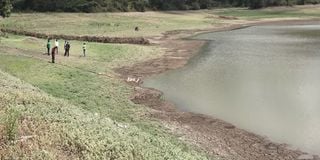Residents suffer as water scarcity returns after dam dried up

Locals at the Kimao dam. The dam is drying up because of human activities in the catchment areas.
Mr Joseph Kipsang, from Kimalel location in Baringo County, is nostalgic about the days when piped water was at his doorstep.
He now has to make a 12km round-trip journey to a nearby source to draw water for his livestock and household use after the Kimao dam was closed when it dried up.
“We had been relieved of the burden of travelling long distances in search of water because of the dam. Each of the 6,000 households had piped water at their doorsteps and it made life easier and we embraced crop farming,” he recalls.
“The dam has dried up solely because of human activities in the catchment areas. Haphazard human activities including farming and bush clearing led to siltation, resulting in soil deposits in the dam. This has led it to hold less water than expected.”
The dam, built by the Kerio Valley Development Authority (KVDA), had a capacity of 600,000 cubic metres of water but has drastically reduced by over 95 percent and is now unable to quench the residents’ thirst.
Hundreds of locals drive their animals to graze on the dry dam, which is now lush with grass. The dam also supported fish farming and board riding.
“We are now back to the old days when we would go far to fetch water, and this will lead to increased food insecurity and poverty,” he said.
Pivotal role
Mr Johana Kemei said the drying of the dam has also affected at least six public schools and hospitals in three sub-locations.
“This is an arid area and the dam played a pivotal role in alleviating water shortages and the effects are now dire. Locals should be taught proper land use so that other water bodies don’t dry up,” he offered.
Mr Kemei said the region has experienced erratic rains in the past three years and the dam was the only remaining water source in the area.
“We had adopted irrigation farming but now with no water in the dam, we are now food-insecure,” he said.
KVDA Managing Director Sammy Naporos said the dam was built to supply water for livestock and domestic use to residents of the semi-arid Marigat and Koriema.
“We installed a 6.2km water supply line with appropriate filtration and capacity and covered the catchment area of over 10 square kilometres. But the population in the catchment has been on the increase, exerting pressure on the dam,” he said.
Also read:Conflict fears over drought in Laikipia
The accelerated erosion and human activities on the catchment area has affected the dam water level.
“There is a lack of water for the communities downstream and town area because of heavy silting of the dam area and the water is at the lowest level ever experienced, forcing us to close it down. The locals have also encroached on the upper catchment, leading to massive soil erosion,” he said.
He said the agency had launched conservation efforts in the catchment area aimed at rehabilitating it through sustainable agroforestry.
“We are issuing mango and avocado seedlings to the locals living upstream to ensure there is sustainable conservation and income for the families,” he said.
Last week, weather experts warned about the drying up of more water bodies in the Kerio Valley due to rampant environmental degradation in catchment areas that had led to heavy siltation.
“If urgent measures are not put in place, all indications show that in less than two decades to come, siltation will have wiped out several water bodies. We will instead be having a flood plain. Whenever there is rain, floods will be devastating and also drought will be severe,” said Simon Cheptot, Elgeyo Marakwet meteorological services director.
He said this would in turn escalate resource-based conflicts between humans and wildlife and have adverse ecological effects.
He advised government and non-government agencies to consolidate their efforts in sensitising wananchi on the importance of environmental conservation, especially in wetlands and riparian areas.





